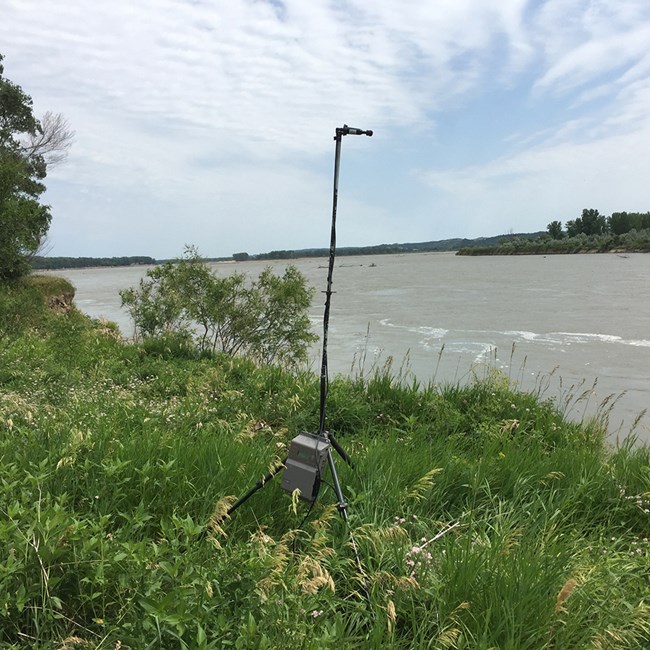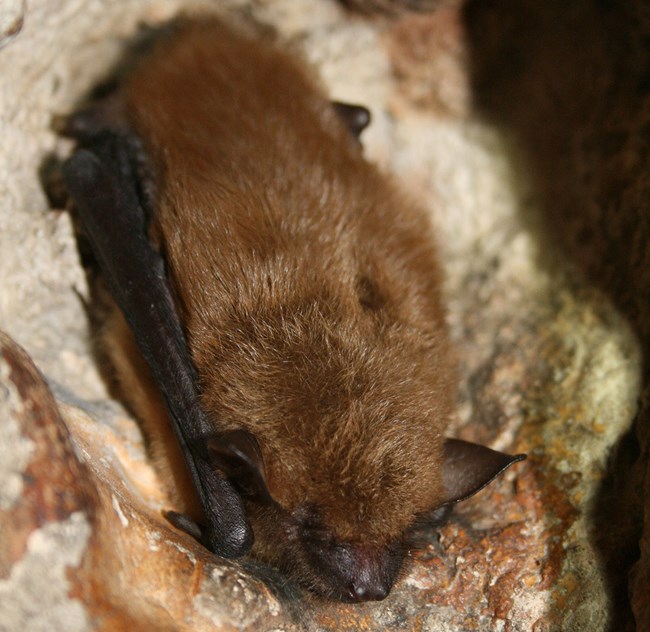Last updated: July 20, 2021
Article
Bat Acoustic Monitoring at Missouri National Recreational River

NPS
Overview
Missouri National Recreational River is comprised of 69,124 acres along the Missouri River in South Dakota and Nebraska. Managed by multiple state and federal agencies, this park is divided into a 39-mile upper reach and a 59-mile lower reach. Riparian forest, wooded uplands, and prairie remnants provide good bat foraging and roosting habitat. Areas with lots of large trees and surface water have high bat activity at Missouri National Recreational River. Some bats can eat thousands of mosquitoes each night making them important for insect control in croplands along the river.
The Northern Great Plains Inventory & Monitoring Network monitors bats to detect long-term trends and to get early warning of undesirable changes in bat populations at the park. A fungal disease called white-nose syndrome is spreading quickly, threatening bat populations in North America. First documented in a New York cave in 2006, this disease is associated with more than seven million bat deaths. It spreads primarily from bat to bat and humans might be spreading the disease by carrying nearly invisible fungal spores on their shoes and clothing from one cave to another. Bat monitoring helps us understand changes occurring with the spread of this devastating disease.
Acoustic Monitoring
Twenty-two acoustic recording stations and five mobile survey routes were established in 2014 and 2015 in the 39- and 59-mile reaches for long-term bat monitoring at Missouri National Recreational River. Acoustic recorders detect the unique ultrasonic calls bats use for echolocation. Several of the monitoring stations were on state and private land and we share results with these network partners. There were 256,687 bat call recordings from stations across all survey nights from 2014 to 2017. The data were analyzed through specialized software programs that make preliminary identifications of the bat species based on individual call characteristics, such as frequency and shape. Some bat species make calls that are similar to other species, which is why researchers with special expertise review the calls and make the final species determinations.

NPS/Isle Royale National Park
Bats in the Park (2014–2017)
| Common Name | Scientific Name | 2014–2017 Status |
|---|---|---|
| Big Brown bat | Eptesicus fuscus | Present |
| Eastern red bat | Lasiurus borealis | Present |
| Hoary bat | Lasiurus cinereus | Present |
| Silver-haired bat | Lasionycteris noctivagans | Present |
| Little brown bat | Myotis lucifugus | Present |
| Northern long-eared bat | Myotis septentrionalis | Present |
| Evening bat | Nycticeius humeralis | Present |
| Tri-colored bat | Perimyotis subflavus | Present (59-mile reach); Probably Present (39-mile reach) |
- Big brown bats were recorded more often than other species throughout the park. Listen to a big brown bat call!
- The threatened northern long-eared bat and the eastern red bat, an eastern species, were detected in higher numbers at Missouri National Recreational River than in other Northern Great Plains Network parks.
- Evening bats, another eastern species, were present and may be expanding westward; they were not found in national parks west of Missouri National Recreational River until detections in 2017 at Niobrara National Scenic River and Scotts Bluff National Monument.
- Areas with lots of large trees and surface water had the highest bat activity at Missouri National Recreational River. These areas provide good roosting and foraging habitat for bats.
- The northern long-eared bat (threatened), little brown bats, and tri-colored bats are particularly vulnerable to white-nose syndrome. The latter two species have been recommended for federal listing.

NPS
White-nose Syndrome
The disease has not yet been detected at the park, but in 2017, the fungus (Pseudogymnoascus destructans) that causes white-nose syndrome was detected on bats for the first time in South Dakota, west of Missouri National Recreational River, and in nearby Ponca State Park in Nebraska. See a map of white-nose syndrome in national parks and learn more about how you can help prevent the spread of this fungus. Continued monitoring, and park staff and visitor observations, will help us protect the bat communities that live and forage in the park.
For More Information
Dan Licht, Midwest Region Wildlife Biologist
Protocol Contact: Northern Great Plains Network
